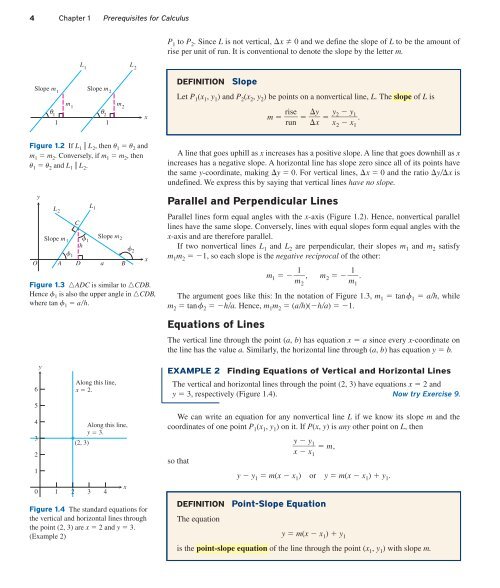Textbook Chapter 1
You also want an ePaper? Increase the reach of your titles
YUMPU automatically turns print PDFs into web optimized ePapers that Google loves.
4 <strong>Chapter</strong> 1 Prerequisites for Calculus<br />
P 1 to P 2 . Since L is not vertical, x 0 and we define the slope of L to be the amount of<br />
rise per unit of run. It is conventional to denote the slope by the letter m.<br />
L 1<br />
L 2<br />
Slope m 1 Slope m 2<br />
m 1<br />
m 2<br />
θ 1<br />
θ 2<br />
1<br />
1<br />
x<br />
DEFINITION Slope<br />
Let P 1 (x 1 , y 1 ) and P 2 (x 2 , y 2 ) be points on a nonvertical line, L. The slope of L is<br />
m r ise<br />
y y<br />
2 y1<br />
.<br />
run<br />
x x 2 x1<br />
Figure 1.2 If L 1 L 2 , then u 1 u 2 and<br />
m 1 m 2 . Conversely, if m 1 m 2 , then<br />
u 1 u 2 and L 1 L 2 .<br />
O<br />
y<br />
L 1<br />
L 2<br />
C<br />
Slope m Slope m 1 1<br />
2<br />
h<br />
<br />
2<br />
1<br />
A D a B<br />
Figure 1.3 ADC is similar to CDB.<br />
Hence f 1 is also the upper angle in CDB,<br />
where tan f 1 ah.<br />
x<br />
A line that goes uphill as x increases has a positive slope. A line that goes downhill as x<br />
increases has a negative slope. A horizontal line has slope zero since all of its points have<br />
the same y-coordinate, making y 0. For vertical lines, x 0 and the ratio yx is<br />
undefined. We express this by saying that vertical lines have no slope.<br />
Parallel and Perpendicular Lines<br />
Parallel lines form equal angles with the x-axis (Figure 1.2). Hence, nonvertical parallel<br />
lines have the same slope. Conversely, lines with equal slopes form equal angles with the<br />
x-axis and are therefore parallel.<br />
If two nonvertical lines L 1 and L 2 are perpendicular, their slopes m 1 and m 2 satisfy<br />
m 1 m 2 1, so each slope is the negative reciprocal of the other:<br />
1<br />
1<br />
m 1 , m m 2 .<br />
m<br />
2<br />
The argument goes like this: In the notation of Figure 1.3, m 1 tanf 1 ah, while<br />
m 2 tanf 2 ha. Hence, m 1 m 2 (ah)(ha) 1.<br />
1<br />
Equations of Lines<br />
The vertical line through the point (a, b) has equation x a since every x-coordinate on<br />
the line has the value a. Similarly, the horizontal line through (a, b) has equation y b.<br />
6<br />
5<br />
4<br />
3<br />
2<br />
1<br />
y<br />
Along this line,<br />
x 2.<br />
(2, 3)<br />
Along this line,<br />
y 3.<br />
0 1 2 3 4<br />
Figure 1.4 The standard equations for<br />
the vertical and horizontal lines through<br />
the point (2, 3) are x 2 and y 3.<br />
(Example 2)<br />
x<br />
EXAMPLE 2<br />
Finding Equations of Vertical and Horizontal Lines<br />
The vertical and horizontal lines through the point (2, 3) have equations x 2 and<br />
y 3, respectively (Figure 1.4). Now try Exercise 9.<br />
We can write an equation for any nonvertical line L if we know its slope m and the<br />
coordinates of one point P 1 (x 1 , y 1 ) on it. If P(x, y) is any other point on L, then<br />
so that<br />
DEFINITION<br />
The equation<br />
y y1<br />
m,<br />
x x<br />
1<br />
y y 1 m(x x 1 ) or y m(x x 1 ) y 1 .<br />
Point-Slope Equation<br />
y m(x x 1 ) y 1<br />
is the point-slope equation of the line through the point (x 1 , y 1 ) with slope m.












